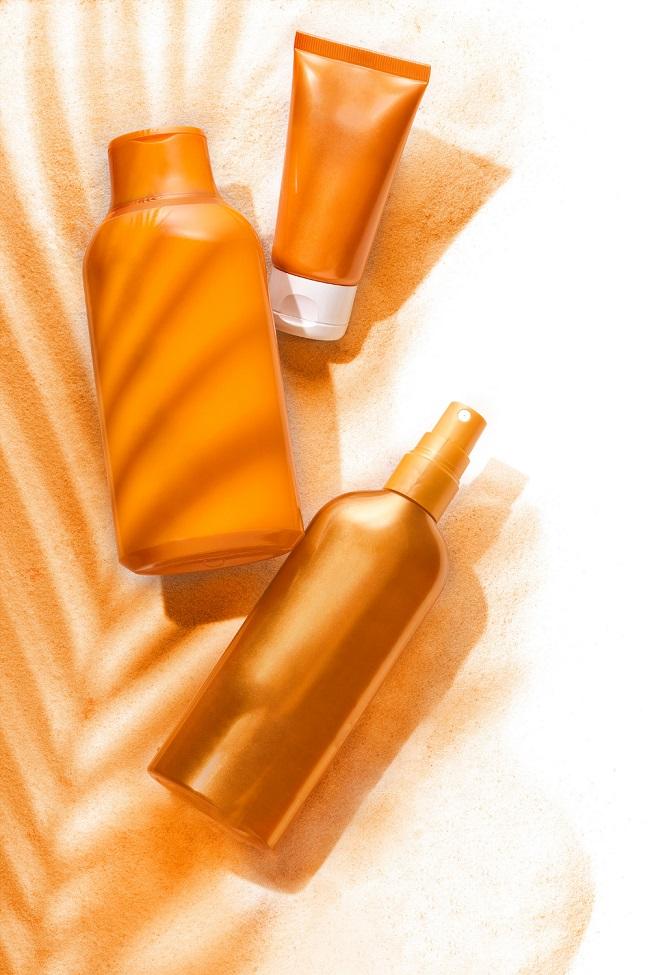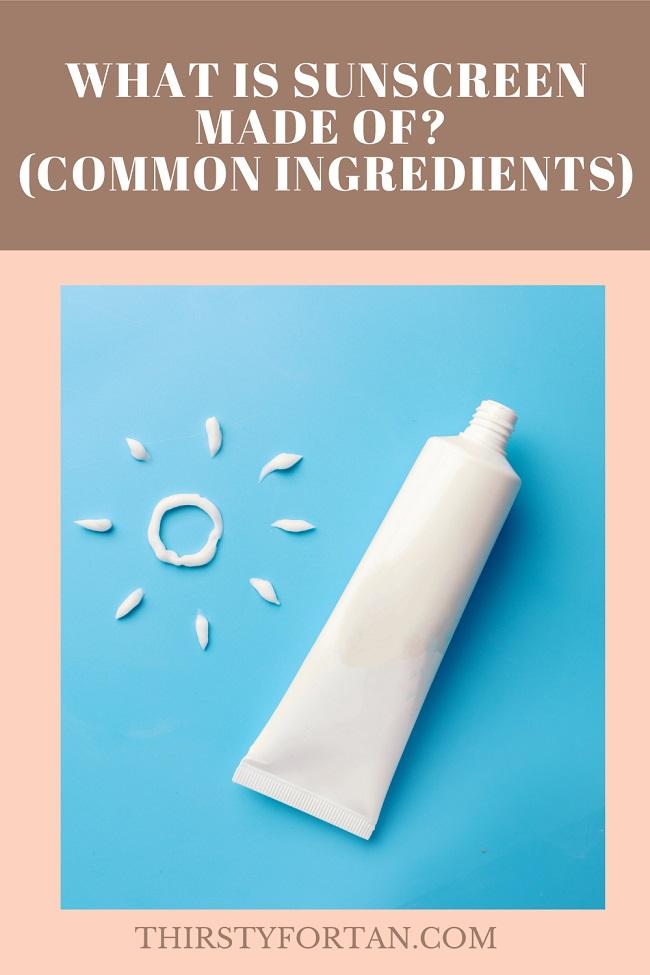As with all of our skincare products, sunscreens contain a variety of ingredients to make the product effective, which can differ between different brands and sunscreens. Although you may not have realised, or considered it before, there is actually a lot of science behind these ingredients and product formulas regarding the way they work.
Mineral vs. chemical sunscreens
Without going into too much detail, as that isn’t the main content of this article, it can be useful to understand some of the differences between mineral and chemical sunscreens, as they are both made up differently, from different ingredients. You can find out whether your product is a mineral or chemical sunscreen due to the UV filters it uses, from looking at the ingredient list.
Firstly, mineral sunscreens work by creating a barrier on the surface of the skin, filtering out any UV rays before they even come into contact. On the other hand, chemical sunscreens are absorbed into the skin and filter the UV rays inside of the upper layers. There are reasons why some people choose one over the other, and mineral sunscreens are generally more popular, and here are some of the reasons why:
- They’re better for the environment as the chemicals are non-toxic to animals and reef-safe, so they don’t damage coral reefs or marine life
- You have to wait for 20 minutes before going out in the Sun with chemical sunscreen, as it has to absorb into the skin, whereas a mineral sunscreen is effective immediately.
- Often, the ingredients in chemical sunscreens can be harsher, and mineral sunscreens tend not to be.
However, in the end, it’s up to you which type of sunscreen you decide to use, and you can always do some extra research of your own to find out which you’d like best.
- 2-fluid ounces of Neutrogena Sheer Zinc Face Dry-Touch Sunscreen Lotion with Broad Spectrum SPF 50 provides superior protection against aging UVA and burning UVB rays to help prevent sunburn
- Specially formulated water-resistant face sunscreen is made with naturally-sourced 100% zinc oxide and features Dry-Touch technology to help ensure it dries with a non-greasy finish
- Free Of: This Coppertone sunscreen lotion SPF 50 with Zinc Oxide is free of oxybenzone, octinoxate, PABA, parabens, dyes and fragrance
- Soothing Formula: Coppertone body sunscreen SPF 50 made with 100% naturally sourced Zinc Oxide plus nourishing botanical extracts (tea leaf, sea kelp and lotus extract) to calm and soothe skin
- We love the reef - to help protect delicate coral reefs, Blue Lizard Sensitive sunscreen contains no oxybenzone or Octinoxate
- Mineral sunscreen, no chemical active ingredients - protects your skin by acting like thousands of tiny mirrors that reflect UV rays away before they enter your body
If you click Buy on Amazon and make a purchase, I'll earn a small commission at no additional cost to you.
Also read: What is A Sunscreen Factor? (How To Pick A Sunscreen?)
Common sunscreen ingredients
As mentioned, some sunscreens can contain lots of ingredients, but not all of them will relate to the sunscreen directly, and some will be very uncommon. Below is a list of common ingredients found in sunscreens and a brief description of them.
UV filters
- Avobenzone: (also known as benzophenone) one of the most common UV filters found in chemical sunscreens and it is used primarily to block out all UVA rays. It is often used with another similar ingredient, such as Mexoryl, as on its own, avobenzone is destabilised as a result of light exposure.
- Mexoryl: as just mentioned, Mexoryl is used with avobenzone in order to stabilize it, but it is also a credible ingredient in itself. Unlike many other ingredients, Mexoryl can often be found in both mineral and chemical sunscreens, as it makes good pairings with both types of ingredients. On its own, it is another highly effective UVA filter and it’s one of the safest filters you can find.
- Oxybenzone: yet another UVA filter, oxybenzone absorbs the rays while it works inside your skin after it has been absorbed from a chemical sunscreen. Unless you’re allergic to it, there aren’t any problems with using this ingredient on your face, but its use does have some negative consequences for the environment. When this chemical gets into the sea, it can damage coral reefs and kill marine life, which has some devastating effects.
- Octyl salicylate: this ingredient, also found in chemical sunscreens can be used to stabilize avobenzone and can also be used as its own UVB absorber. Although it is perfectly safe on its own, you often find octyl salicylate with other potentially harmful ingredients, such as avobenzone, so it’s best to check what else is in the formula.
- Octocrylene: unfortunately, this ingredient isn’t as common as some of the others, but it has some great benefits, and there is no evidence that it can cause any danger to your skin. It is an ester (a certain type of ingredient in skincare) that is proven to boost the performance of sunscreen and can protect against both UVA and UVB rays. As long as it comes in concentrations of up to 10%, there’s absolutely nothing to worry about.
- Homosalate: just like many others we’ve seen on this list, Homosalate protects your skin against UVB rays in chemical sunscreens. Although there aren’t any solid studies to show that there are definitely side effects from this ingredient, some evidence suggests that it may impact hormones, so it’s good to find a more reliable alternative.
- Octinoxate: another ester, Octinoxate filters out UVB rays and was one of the first ingredients discovered, being first produced in the 1950s. Despite how reliant skincare has been on it for so long, studies have shown that it is a toxic ingredient and can lead to developmental and reproductive toxicity as it is another hormone disruptor.
- Zinc oxide: time for an ingredient found in mineral sunscreens this time! Zinc oxide is one of the most well-known mineral sunscreen ingredients and it’s a great one for deflecting both UVA and UVB rays off your skin and has even been shown to reduce acne and reduce inflammation and irritation.
- Titanium dioxide: finally, this UV filter, which is also used in mineral sunscreens is used to thicken and smoothen the formula, while protecting your skin against both types of UV rays at the same time. There are no safety concerns, and titanium dioxide is approved for safe use in sunscreens. Not to mention, both titanium dioxide and zinc oxide are reef-safe ingredients, so they won’t damage marine life.
Also read: 7 Things A Sunscreen Does to Your Skin (Explained)
Other ingredients
- Methylisothiazolinone and methylchloroisothiazolinone: (MIT and CMIT) these chemicals are preservatives, which are often found in liquid cosmetic products, and it’s best to avoid them if possible, as they can be damaging to the body in certain situations.
- Parabens: you may have seen some brands promoting that their products are ‘paraben-free’ before, suggesting that perhaps they’re not a good skincare ingredient. Well, parabens are used in cosmetics as a preservative, and they are very effective at this, but they are known to have some alarming side effects, such as the disruption of hormonal function. Avoiding parabens and finding something which has a different preservative is much safer.
- Formaldehyde releasers: you can find out more about whether a certain ingredient is a formaldehyde releaser by simply searching up its name, and it will say if it is. These ingredients are a type of preservative, but they can be dangerous and have concerning side effects, so it’s best to avoid them.
- Phenoxyethanol: this preservative is a much safer one and has been approved globally for use in skincare and cosmetics products in concentrations of up to 1%. Sometimes, when used with another preservative, such as ethylhexylglycerin (which is also safe), there’s no need to use this much anyway.
- Humectants: (including glycerin, hyaluronic acid, propylene glycol, butylene glycol) as this is a term most people wouldn’t have heard of before, humectants are a category of skincare ingredients which attract water and therefore hydrate your skin. They’re most commonly found in moisturisers but are also found in sunscreens and other products to prevent the formula from drying out your skin. The examples listed above are just some of the most common ones, but there are others you may find, too.
- Fragrance: everyone knows what fragrance is in its most basic terms – it adds a scent (usually pleasant) to your product. It’s easy to see why fragrance is popular, but it isn’t necessary for the product to actually work, and it can actually be very harsh on the skin, and cause lots of irritation, especially for sensitive skin. Because of this, fragrance-free formulas are the best way forward.
Final thoughts
There are lots of ingredients found in sunscreens, and it’s really useful to know what’s in yours in order to know what you’re putting on your face (and body!). You can find out what ingredients are in your product by either looking at the packaging or taking a look at the product description online, where they should also be listed.






